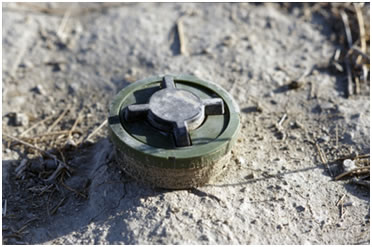Topic 6: Personal security
Security Issues and Loss of Humanitarian Space

Bamiyan, Afghanistan
A landmine. Afghanistan is covered with metal scraps and live munitions from 20 years of fighting (01 December 2001).
Source: http://www.foun.org.au , Photo # 31623 accessed April 2011
Up until the end of the 1980’s it was generally perceived by humanitarian workers that they would be afforded a relatively high degree of protection by the majority of stakeholders in a conflict situation by all stakeholders involved. While there were always risks of death and injury through accidents, as well as the possibility of being robbed, there was generally little fear that as individuals they were being targeted as aid workers per se.
With the increasing involvement of military forces in peacekeeping operations it became increasingly difficult for local community members to distinguish between the military peacekeeper, the traditional UN/NGO humanitarian practitioner, the person working in a provincial reconstruction team, or others employed by private service providers. With a rising number of ex-military personnel working for NGOs there was also the occasional accusation that some were involved in espionage and using the cover of humanitarian work to report back on military-related observations.
Whereas the role of the humanitarian worker was once inviolate, increasingly some began to be targeted for political or strategic purposes. The car-bombing of the UN headquarters in 2003 which killed, amongst others, the UN’s Special Representative, was an example of this. Another loss of perceived neutrality was the murder in 2006 of 17 employees from a French NGO in Trincomalee in Sri Lanka (sometimes referred to as the Muttur Massacre).
In order to create a safer environment for their staff, both national and expatriate, NGOs and UN agencies have undertaken increasingly sophisticated security management training. A principal agency involved in this has been RedR (http://www.redr.org) which offers personal security and communications training on a regular basis at various global locations, including Australia. Other training providers offer similar courses for specific clientele e.g. for those working in the media.
The following four texts provide a solid foundation of the security management challenges currently facing the international humanitarian community:
Koenrad van Brabant
Koenrad van Brabant’s highly acclaimed text titled Operational Security Management in Violent Environments was produced in 2000, with an updated version in 2010.
van Brabant observes the following concerning the previous decade:
- An increasing rate of major attacks against aid workers, but with most of these concentrated on a small number of highly violent conflict situations, notably Afghanistan (and more recently, Pakistan), Iraq, Somalia and Darfur.
- In some of the most violent settings, the increasing use of more sophisticated, organised and lethal attacks, the evident targeting of internationals, and more politically orientated motivations amongst perpetrators.
- An overall slight decline in aid worker casualties in other settings around the world, despite growing numbers of field staff, this indicating better security management within the sector.
- A long-term trend of increasing attacks for national staff relative to their international counterparts.
Stoddard and Harmer
Aid Worker Security Database
The Aid Worker Security Database, see http://www.aidworkersecurity.org
Whilst security management is important, it is interesting that the 2010 IASC Haiti Real Time Evaluation suggested that the security management for NGO staff has been over-emphasised. Practically speaking this means that development practitioners have not given themselves sufficient opportunity to develop meaningful relationships and dialogue with affected communities, which in turn has worked against their recovery/development effectiveness – i.e. they have relied too much on protection and not enough on gaining acceptance (as expressed in van Brabant’s Security Triangle).
 |
|
|
|